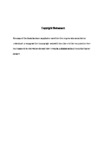CLINICAL OUTCOMES POST-IMPLANTATION OF MULTIFOCAL AND TORIC INTRAOCULAR LENSES
| dc.contributor.supervisor | Buckhurst, Phillip | |
| dc.contributor.author | Law, Elizabeth Martha | |
| dc.contributor.other | Faculty of Health | en_US |
| dc.date.accessioned | 2021-01-19T14:50:33Z | |
| dc.date.issued | 2020 | |
| dc.identifier | 10513711 | en_US |
| dc.identifier.uri | http://hdl.handle.net/10026.1/16809 | |
| dc.description.abstract |
In order to increase spectacle independence following cataract surgery and intraocular lens (IOL) implantation; correction of spherical refractive error, astigmatic error and presbyopia should all be given careful consideration. There are many premium IOLs, including multifocal intraocular lenses (MIOLs) and toric intraocular lenses (TIOLs), available to surgeons. In order to select the appropriate IOL to meet a patient’s lifestyle and expectations, clinicians must fully understand the characteristics of MIOL and TIOL designs. To date, there remain unanswered questions pertaining to MIOLs and TIOLs and by rigorous comparison of such lenses, this thesis aims to address some of the gaps in the current literature. This thesis aims to evaluate a robust protocol for investigating clinical outcomes in MIOLs that would allow for comparison between future studies. This methodology was used in a randomised control trial and a cohort study. Included in this protocol is the detailed analysis of defocus profiles. This thesis investigates polynomial curve fitting to establish the most suitable curve and curve fitting method for use in future analysis of MIOLs with detailed defocus metrics. Defocus curves can highlight the differences in optical performance in MIOLs of differing addition powers, however, to add further complexity, previous literature has highlighted that addition power can vary individual to individual based on their ocular anatomy. Thus, investigation of an easily accessible clinical method to predict the likely achieved addition power post-implantation was performed. A randomised intra-patient contralateral eye study assessed refractive outcomes and rotational stability in TIOLs. In addition, the performance of the corresponding manufacturer’s calculators was evaluated in regard to refractive predictability and appropriate TIOL selection. This thesis highlights the clinical features of modern MIOL and TIOL designs, demonstrating both the benefits and challenges incurred following implantation. | en_US |
| dc.description.sponsorship | University of Plymouth | en_US |
| dc.language.iso | en | |
| dc.publisher | University of Plymouth | |
| dc.subject | intraocular lenses | en_US |
| dc.subject.classification | PhD | en_US |
| dc.title | CLINICAL OUTCOMES POST-IMPLANTATION OF MULTIFOCAL AND TORIC INTRAOCULAR LENSES | en_US |
| dc.type | Thesis | |
| plymouth.version | publishable | en_US |
| dc.identifier.doi | http://dx.doi.org/10.24382/486 | |
| dc.rights.embargodate | 2022-01-19T14:50:33Z | |
| dc.rights.embargoperiod | 12 months | en_US |
| dc.type.qualification | Doctorate | en_US |
| rioxxterms.version | NA | |
| plymouth.orcid_id | 0000-0002-8174-6351 | en_US |
Files in this item
This item appears in the following Collection(s)
-
01 Research Theses Main Collection
Research Theses Main


